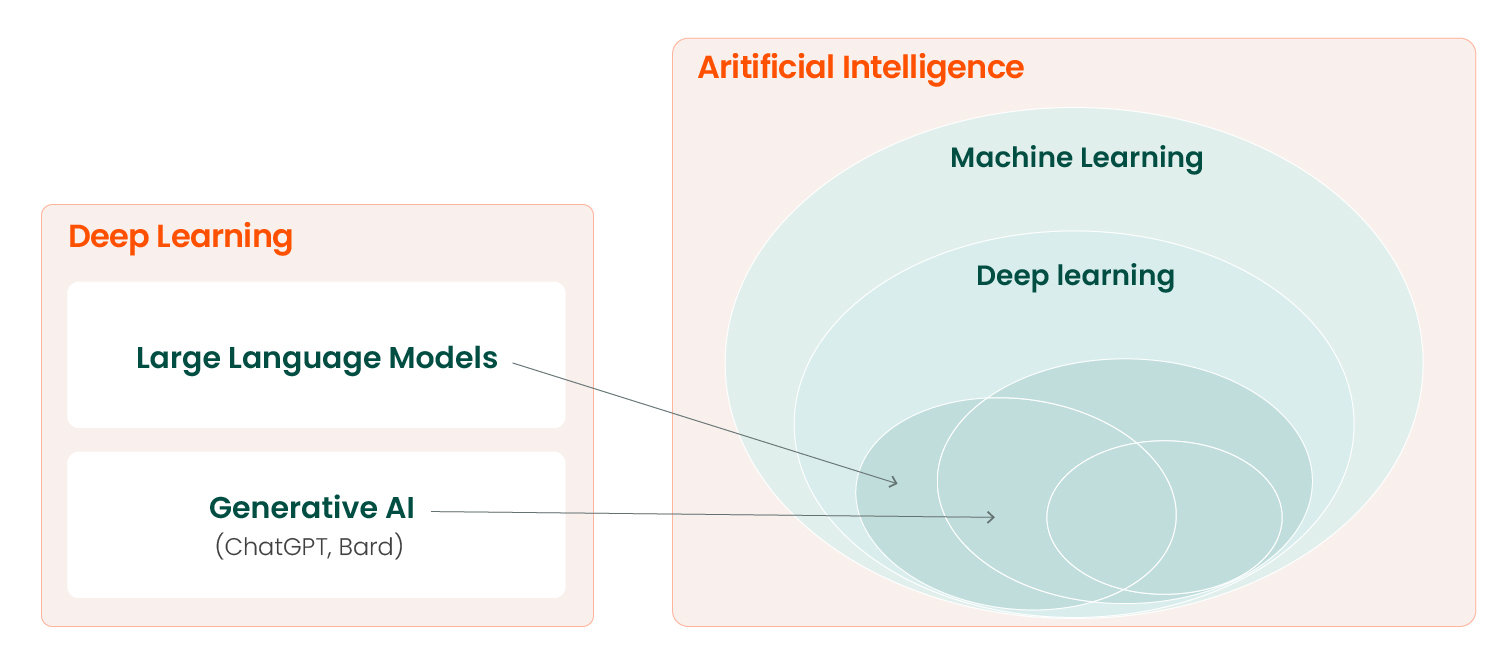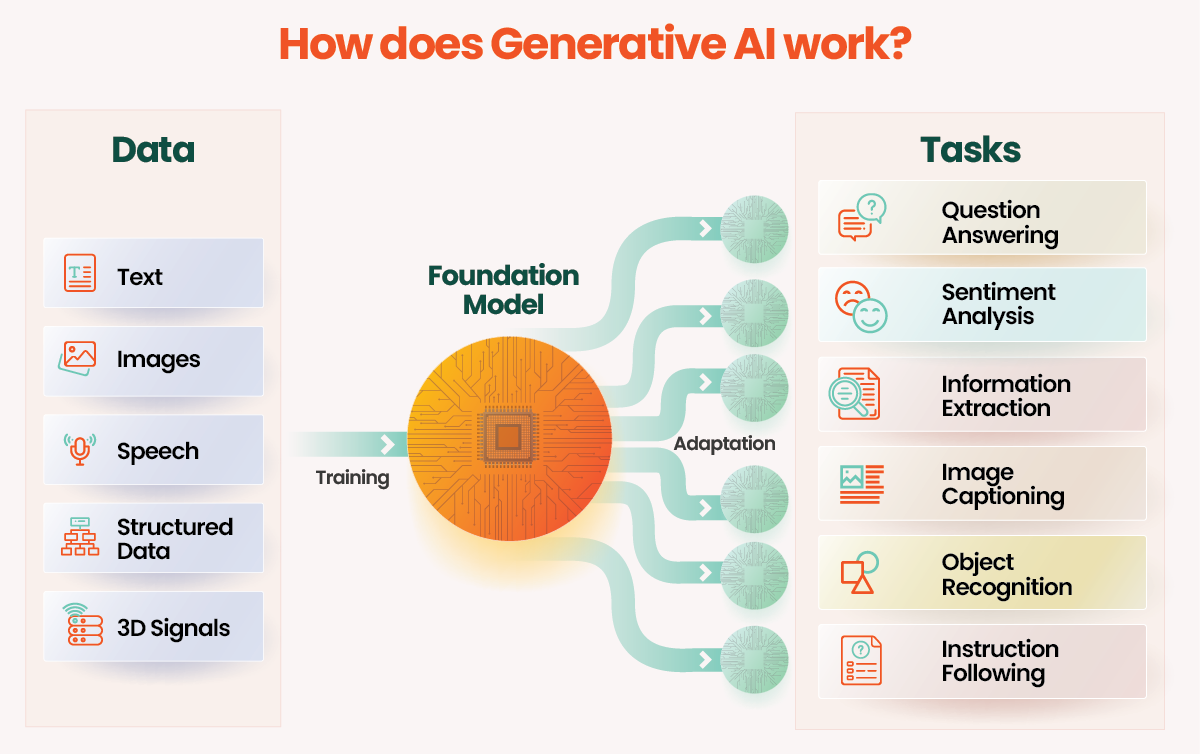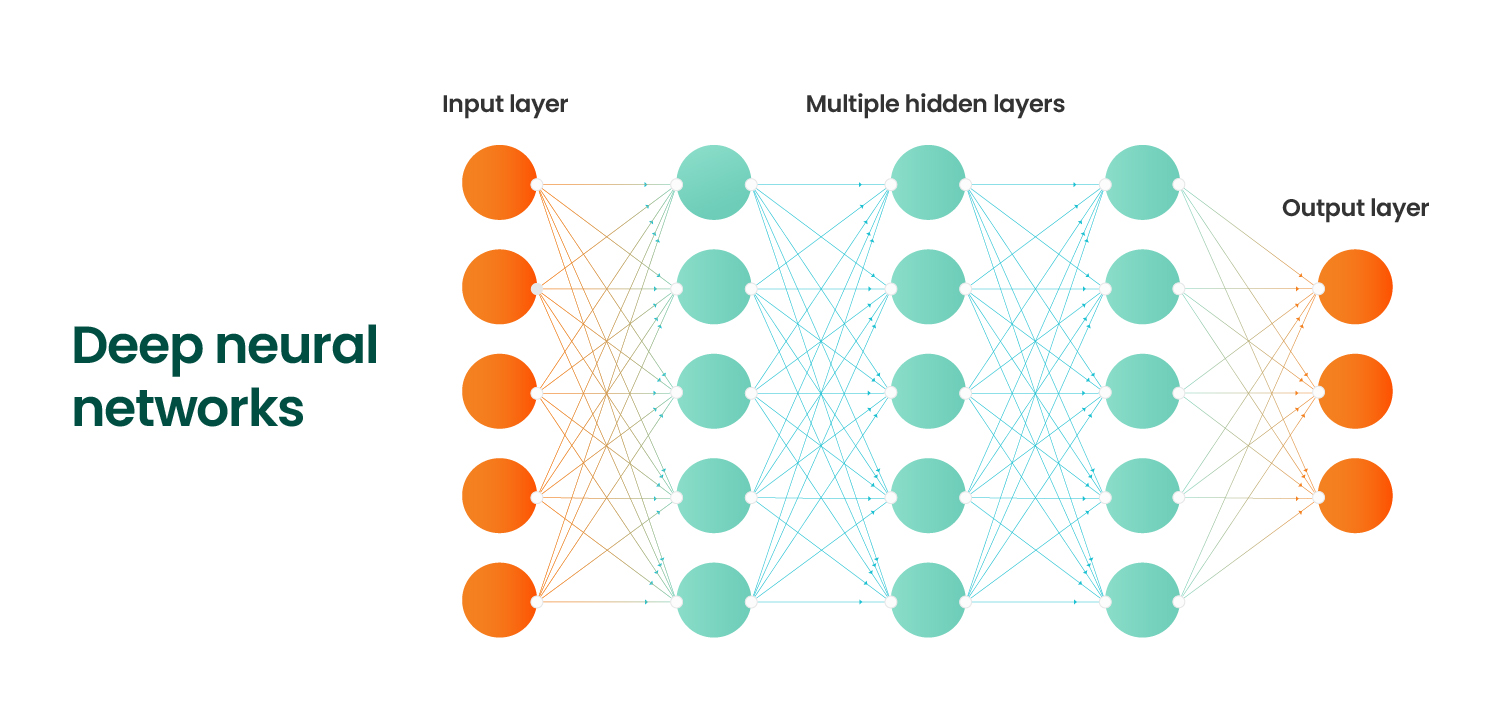Introduction
Welcome to your ultimate guide to all things Generative AI— it’s Generative AI for Dummies, it’s a GenAI FAQ, it’s... GenAI 101! Let’s dive in.
What is Generative AI?
The success of ChatGPT by OpenAI has launched Generative AI technology into the mainstream. Gaining over 100 million users within two months of its release, ChatGPT may be the fastest-growing app in history — indicating just how important the field of Generative AI has become.
But what exactly is Generative AI technology and how does it work? In simple terms, GenAI models are able to produce original content, such as text, images, synthetic data, or even music, that is very similar to what a human can produce. The technology acts like a virtual storyteller, artist, assistant, or co-pilot whom you can instruct to create content on demand. GenAI models are trained using massive datasets and learn to mimic their training data to generate new content.
Industry experts like McKinsey estimate that Generative AI will add up to $4.4 trillion to the global economy. To grasp the future of GenAI, it is helpful to understand the technology’s history and evolution into today.
The History of Generative AI
The history of Generative AI dates back to the 1950s, when computer programmers developed the first neural networks (NNs) inspired by the human brain. NNs used machine learning to independently analyze data sets and identify patterns. Although the early NNs were limited by a lack of computing power and small data sets, they laid the foundation for future developments.
The 2000s-2010s marked a turning point in the evolution of Generative AI. Equipped with more computing power than ever before, AI researchers revisited NNs— and in 2014, computer scientist Ian Goodfellow introduced Generative Adversarial Networks (GANs), a breakthrough in the field of GenAI. GANs are machine learning models composed of two NNs that work together to produce highly realistic data, such as images, audio, or text.
In the past decade, NN models have improved through deep learning techniques, in which multi-layered networks are used to process data. A prominent example is the transformer model, first introduced in 2017 by Google researchers, which is the base of OpenAI’s GPT (Generative Pre-trained Transformer) series.
Transformers have revolutionized GenAI because of their ability to process large unlabeled bodies of text and identify the meaning of words from context, allowing Large Language Models (LLMs) to scale significantly. Gaining over 100 million users in just two months after its release in November of 2022, ChatGPT has automated creative work, enabled personalized solutions, and transformed industries in exciting ways. As the popularity and sophistication of GenAI models improves, the future of GenAI is full of possibilities.
How is Generative AI different from AI?
AI encompasses a wide range of technology, including Generative AI, machine learning, and natural language processing. It aims to replicate human intelligence, learning, and decision-making to complete tasks that would normally require human input.
Generative AI refers to AI models designed specifically for generating new data when prompted. Examples of GenAI applications include chatbots, image generation, language translation, music composition, and more.
How are GenAI, Machine Learning, and Large Language Models related?

Image Note: When replicating this image, please leave out the smallest blue circle that is unlabeled. | Source
In a nutshell, Generative AI models rely on Machine Learning (ML) techniques to process and learn from vast datasets. Large Language Models (LLMs), such as ChatGPT by OpenAI, are a type of GenAI model that specialize in understanding human language and generating human-sounding responses.
Let’s dive deeper into these two key terms:
- Machine Learning (ML) is a subfield of AI that enables GenAI systems to learn from data. ML is a key component of GenAI and Large Language Models (LLMs) because it trains the models to analyze datasets and recognize patterns. One important type of ML used to train GenAI models is Deep Learning, which involves layering neural networks to understand complex data. Through ML operations, or MLOps, enterprises are able to develop and scale ML models that improve the efficiency of their organizations.
- Large Language Models (LLMs) are a type of GenAI model that specialize in processing human language, exemplified by OpenAI’s GPT series. Understanding and generating human language, or Natural Language Processing (NLP), is quite complex. This is why LLMs such as ChatGPT use Machine Learning, especially Deep Learning, to power their NLP abilities. Many enterprises are setting their focus on LLM operations, or LLMOps, to successfully develop, deploy, monitor, and maintain LLMs that meet their specific use cases.
How does Generative AI work?

This diagram demonstrates how Generative AI models function at a high level. | Source
GenAI operates by training on vast amounts of data to learn patterns and relationships, subsequently creating new data that mirrors these learned patterns. Let’s go into more detail about what GenAI models need to function:
- Data collection: First and foremost, massive amounts of data must be collected in order to train a GenAI model. If you want to design an image generation model, for example, then you will need to gather large volumes of images to teach the model. The amount and type of data needed for training will depend on the design, complexity, and function of the GenAI model.
- Training phase: Once the necessary data has been gathered, GenAI models utilize Machine Learning to analyze the data. The models can employ different learning approaches such as unsupervised or semi-supervised learning, based on whether the input data is labeled or unlabeled. Using neural networks, the model identifies patterns in the data and learns to replicate them.
- Generating new data: After completing its foundational training, the model is finally ready to generate new data in response to prompts. For instance, when using ChatGPT, the model starts with a given text prompt entered by a user, such as, “Write a paragraph about dogs.” Based on the patterns and context learned during training, the model selects and arranges the right words for a coherent answer.
Unlock New Business Value with a GenAI Structure that Scales.
What are the different types of GenAI models?
Popular generative models include Generative Adversarial Networks (GANs), Variational Autoencoders (VAEs), and Transformer-based models.
- Generative Adversarial Networks (GANs): GANs are a type of GenAI model used for generating new data points, such as images, text, or audio, that mimic a given dataset. They consist of two neural networks, a generator and a discriminator, which compete to produce increasingly realistic data.
GANs are used for generating text, artwork, images, audio, video, style transfer, and more. GANs’ many capabilities include creating lifelike “deepfake” videos that are almost indistinguishable from real videos.
- Variational Autoencoders (VAEs): VAEs are models that specialize in generating representations of data. VAEs consist of two neural networks: an encoder that maps the essential features of input data and a decoder that generates new data resembling the input data.
VAEs are used for data compression, detecting anomalies in data, “denoising” or clarifying data, labeling data, machine learning, image generation, enhancing image resolution, style transfer, and more.
- Transformers: Transformers are versatile GenAI models widely used in natural language processing and machine learning. A key feature is their self-attention mechanism, which enables Transformers to consider different parts of the input data simultaneously. The model’s self-attention capacity and stacked layers of neural networks allow it to understand complex patterns and nuances in data.
Transformers are the foundational framework of OpenAI’s GPT series, Google’s BERT, and various other natural language processing and machine learning applications. The model is used for computer vision, speech recognition, robotics, medical drug discovery and more.
To summarize: GANs use two opposing neural networks to generate highly realistic content, such as images, videos, and audio that appear human-made. VAEs use encoder and decoder neural networks to process data, and specialize in data representation, generation, and augmentation. Transformers possess self-attention mechanisms and layered neural networks, and are widely used in machine learning and natural language processing tools like ChatGPT.
How are neural networks transforming generative AI?
Neural Networks (NNs) have enabled Generative AI to produce more creative, detailed, and diverse outputs. Let’s review what NNs are and how they are used today.
What are Neural Networks and how do they work?
Neural Networks (NNs) are a machine learning model that transformed GenAI into what it is today. Inspired by the structure of the human brain, NNs are composed of interconnected neurons that are organized into layers. Raw data is received by the input layer and processed through deeper “hidden” layers until it reaches the output layer, which produces the NNs’ final predictions or classifications. NNs can be utilized to learn patterns, classify data, make predictions, perform natural language processing, and more, making them essential to GenAI models.

When recreating the diagram, please write “Multiple hidden layers” instead of “Multiple hidden layer” as shown on the image. | Source
How are Neural Networks (NNs) used today?
As NNs continue to improve overtime, GenAI models are becoming more sophisticated and powerful as a result. In particular, deep learning architectures— an advanced system of NNs— have revolutionized GenAI. NNs have transformed the fields of Machine Learning and Natural Language Processing. By adding deeper, more complex layers of neurons to NNs, GenAI models are able to learn from complicated data distributions, generate increasingly realistic content, augment complex data, and even compose original music.
What are Dall-E, ChatGPT, Bard and MosaicML?
Dall-E, ChatGPT, Bard and MosaicML are popular generative AI tools.
Dall-E, ChatGPT, Bard, and MosaicML are advanced GenAI tools, with Dall-E generating images, ChatGPT and Bard generating text, and MosaicML creating custom GenAI models for enterprises, respectively.
Let’s explore each of these models in brief:
- Dall-E is an image generation model first released by OpenAI in January of 2021. A user inputs a textual description and then Dall-E generates an image that corresponds to the description. Dall-E also offers prompt rewriting assistance, adjustments to image quality and detail, and mimics the style of famous artists.
- ChatGPT is a popular Large Language Model (LLM) designed to generate human-sounding text or data visualization in response to prompts. First released in November 2022 by OpenAI, it gained over 100 million users in just two months. Based on OpenAI’s GPT architecture, the model excels at understanding and replicating the nuances of human language to create new, custom content for users on command. Users are now able to upload multiple files for analysis, generate advanced data analytics and visualization, integrate with OpenAI's other models like Dall-E, and connect ChatGPT to the internet.
- Bard is an LLM released by Google in March 2023 that functions similarly to ChatGPT and generates human-like content based on prompts. Bard can also help with math equations, analyze YouTube videos, access Google Search, and integrate with Gemini—Google’s most advanced AI model— for expanded capabilities. While Bard and ChatGPT are both transformer GenAI models, Bard runs on Google’s LaMDA architecture while ChatGPT runs on OpenAI’s GPT architecture.
- MosaicML is a platform for enterprises to create and customize their own Generative AI models. It was first launched in 2021 and then acquired by Databricks in July of 2023 for $1.3 billion dollars. MosaicML specializes in helping businesses build and train LLMs that utilize their data for a variety of cost-effective use cases.
What are the applications of Generative AI?
Generative AI has broad applications that include the following use cases:
- Text generation and Natural Language Processing are among the most popular applications of GenAI today, as seen in models like ChatGPT. Use cases include the following:
- Content Generation: Writing text, articles, or stories using natural, human-like language and tone.
- Language Translation:Improving language translation systems.
- Chatbots and Virtual Assistants:Creating virtual agents capable of having helpful, effective conversations with humans.
- Text Summarization: Generating summaries of lengthy texts.
- Sentiment Analysis: Understanding and classifying the tone and emotion embedded in text data.
- Image generation and manipulation are widely used applications of GenAI technology. Tools like Dall-E by OpenAI allow users to create images based on their textual descriptions. Key use cases include the following:
- Image creation:Generating realistic images of objects, scenes, people, or anything else a user desires.
- Style Transfer:Transferring the style of one image to another and producing specific visual effects.
- Super-Resolution: Enhancing the resolution and quality of images.
- Video Generation and Deepfake Creation: Producing extremely realistic videos, or “deepfakes,” and manipulating existing videos.
- Voice Generation: Creating human-like voices for voice assistants, navigation systems, and other applications.
- Music generation: Synthesizing instrument sounds and composing melodies, accompaniments, or entire compositions to assist musicians.
- Game development: Generating virtual game environments, characters, and assets.
- Data augmentation: Creating synthetic data to enhance training datasets for machine learning models.
- Anomaly detection: Detecting anomalies in data by generating a model of “normal behavior” for a dataset and then identifying deviations from it.
Discover how generative AI is changing the game for customer interactions.
Industry Use Cases for Generative AI
GenAI technology is being deployed across many industries in diverse use cases. Today, GenAI is used in retail, consumer packaged goods (CPG), manufacturing, banking, finance, telecommunications, healthcare, travel and hospitality, and more. Let’s look at some key examples of how leading companies are applying GenAI in their fields.
GenAI in Retail
GenAI technology is utilized by major online retailers including Amazon, L’Oreal, and Wayfair. In 2023, Amazon launched GenAI tools to help sellers write product descriptions and enable advertisers to create custom product images. L’Oréal uses GenAI to allow customers to virtually try on makeup. Wayfair released the Decorify app in 2023, enabling customers to view realistic images of furniture in their own home.
Retailers are increasingly using GenAI to personalize their marketing, product recommendations, and user experience based on customer profiles. Additionally, many e-commerce sites use GenAI-powered virtual customer support agents and chatbots.
GenAI in Consumer Packaged Goods (CPG)
GenAI is leveraged to help research, design, and create new products in the Consumer Packaged Goods (CPG) industry. Companies including PepsiCo, Nestlé, Mars, and Campell’s reportedly use Tastewise, a GenAI platform that helps validate new product ideas and generate market research reports. Tastewise’s new feature, TasteGPT, is a conversational chatbot that can answer important product and market questions like “What are the current beverage trends for Gen Z consumers?”
In a climate where consumer trends are constantly shifting, GenAI is enabling CPG enterprises to quickly research, understand, and create products that resonate with consumers.
GenAI in Manufacturing
In the manufacturing industry, a key use case for Generative AI is Predictive Maintenance (PM). PM enables manufacturers to anticipate and prevent equipment failures before they occur so that production processes can continue without interruption. Deloitte estimates that Predictive Maintenance increases productivity by 25%, reduces breakdowns by 70%, and lowers maintenance costs by 25%. GenAI algorithms can analyze the performance history and sensor data from manufacturing equipment to predict failures and determine the optimal time for maintenance— so it's no surprise that leading companies including IBM, General Electric, SAP, and Siemens are using this technology today.
In addition, Boeing uses GenAI-powered technology to generate and test virtual prototypes of their airplanes and simulate the production process. General Motors uses generative models to optimize and test lightweight automotive parts, resulting in the reduction of hundreds of pounds of weight on certain vehicles.
GenAI in Banking & Finance
In 2018, Wells Fargo launched a GenAI-powered predictive banking feature for its mobile banking customers that analyzes account information to provide personalized account insights and financial guidance. For example, if a customer receives a monthly deposit that is higher than usual, they may be prompted to transfer money into savings. Royal Bank of Canada (RBC) Capital Markets expanded their AI-powered electronic trading platform, Aiden, in 2022. Aiden uses deep reinforcement learning to adapt to market conditions in real time, helping customers reduce price slippage and market impact when trading.
Since 2020, J.P. Morgan Chase has used AI technology, including Large Language Models (LLMs) to improve payment validation screening and processing. By deploying these models, J.P. Morgan Chase has reduced fraud levels, improved customer experience, and cut account validation rejection rates by 15-20%. In June of 2023, Microsoft announced a partnership with Moody’s Corporation to create new data and risk management tools for the financial services industry based on Microsoft’s Azure OpenAI Service— another exciting step for GenAI in finance.
GenAI in Telecom
A major use case for Generative AI in the Telecom industry is network optimization, which uses generative models to design and optimize telecommunication networks to maximize capacity, efficiency, and effectiveness. For example, GenAI can be used to predict network demand based on historical data, enabling providers to increase capacity at peak hours. Ericsson, a leading provider of telecom infrastructure, offers AI-based network optimization services globally. Customers using this service include India’s Airtel, Indonesia’s XL Axiata, Pakistan’s Jazz, and more.
Telecom companies like AT&T are also deploying GenAI to boost employee efficiency. In June of 2023, AT&T launched Ask AT&T, a Generative AI tool that uses OpenAI’s ChatGPT functionality and AT&T’s internal knowledge to help employees. So far, Ask AT&T’s has improved the productivity of software developers, simplified internal resources, and helped translate documents.
GenAI in Healthcare
In the healthcare industry, GenAI models are particularly useful for drug discovery. Models can accelerate the lengthy research and development process by designing molecular structures for potential new drugs. In 2023, Insilico Medicine’s Pharma.AI platform developed a novel treatment for cancer tumors that received FDA approval for clinical trials— a milestone for GenAI-produced drugs. Additionally, Roche subsidiary Genentech announced a strategic partnership with NVIDIA to discover, develop, and deliver new drugs more efficiently using GenAI.
Another use case for GenAI is medical imaging, where doctors and researchers can enhance patient medical images and receive assistance in detecting diseases. Aidoc, an AI-powered radiology company, uses generative models to improve the accuracy of medical image analysis, helping doctors detect abnormalities in CT scans. Siemens’ Deep Resolve Boost product aids in “denoising” MRI scans to enhance the resolution of images, and reduces the time required to produce a medical scan.
Discover how Tredence Developed GenAI-driven Patient-centered Care Plans for a US-based Healthcare Provider.
GenAI in Travel & Hospitality
In the hospitality and travel industry, GenAI tools are enhancing customer support and customizing travel plans. Since 2017, travel booking platforms including Expedia, Booking.com, Marriott International, and Hilton Hotels have used GenAI-powered chatbots to assist users with travel questions, booking changes, and other support requests.
Advanced chatbots are helping businesses offer their customers even more travel support and personalization. Kayak and Expedia announced their integrations with ChatGPT in March 2023, creating virtual travel assistants that allow customers to ask questions like “Where can I fly to from NYC for under $500 in April?” and receive personalized recommendations. In June of 2023, Airbnb’s CEO announced plans to build the “ultimate AI concierge” that learns about a user overtime to create a tailored customer experience.
What are the benefits of generative AI?
GenAI technology offers a wide range of benefits including rapid content generation, data augmentation, personalized solutions, and fostering creativity.
1. Rapid content generation
GenAI models can streamline the creative process by quickly producing high-quality content, like text, images, videos, music, or art, tailored to a user’s specific requirements. This is very useful for developing creative projects, creating original marketing materials, conducting research, brainstorming ideas, writing articles and summaries, and much more.
2. Data augmentation
Generative AI helps augment datasets by creating synthetic data that mimics an original dataset. There are many applications for data augmentation, including the creation of synthetic images, videos, text, audio, code and more. This is highly valuable for training Machine Learning programs, where providing larger and more diverse datasets helps improve the performance and accuracy of models.
3. Personalized solutions
Generative AI can analyze an individual's preferences, demographic profile, interests, and past behaviors to provide personalized recommendations. Applications include customized content suggestions on video streaming platforms, news feeds, and music streaming services. GenAI can also personalize product recommendations, health and fitness advice, diet and meal planning, style and fashion suggestions, and much more.
4. Fostering creativity
GenAI technology helps foster creativity in a variety of ways, including through style transfer, image manipulation, and art creation. For example, models like DeepDream allow a user to enter a text description of a desired artistic image, specify stylistic features, and receive an original image that brings their idea to life. GenAI can be used to generate music, poetry, architectural designs, virtual gaming worlds and more, allowing users to create unique art in a matter of seconds.
What are the limitations of generative AI?
Although GenAI technology is progressing quickly, there are still limitations that must be considered. These limitations include the need for large training datasets, massive computational requirements, and the potential for generating misleading information.
- Large training datasets: Large Language Models (LLMs), like OpenAI’s GPT architecture, require extensive and diverse datasets for training in order to learn, understand, and replicate natural human language. This can mean compiling and structuring terabytes of data, or billions of data points, may be required in order to capture the nuance of natural language.
- Massive computational requirements:Once the initial training dataset has been assembled, there are significant computational requirements for training generative models. It takes tremendous processing power, memory, technical infrastructure, and expertise to facilitate the Machine Learning process, which smaller organizations or developers may not have access to.
- Generating misleading information:Because generative models are trained on past data, they often lack up-to-date information and cannot access current events. Additionally, they may replicate inaccuracies from biased or incorrect training data. Since popular models cannot fact-check themselves, they may generate answers that seem plausible but are factually incorrect.
What are the concerns regarding generative AI?
Generative AI models offer many exciting benefits and use cases, but there are serious concerns including the spread of misinformation, artistic plagiarism, and issues of hallucinations, bias and ethics, and privacy.
- Spread of misinformation: Because GenAI models can produce content that is difficult to distinguish from reality, they may be used to spread misinformation. AI-generated “deepfakes,” or highly realistic videos, have already been used to promote fake news, including a viral video of U.S. President Joe Biden in May of 2023.
- Artistic plagiarism: GenAI platforms like Stable Diffusion and DeepDream, which enable users to create art from text prompts, have raised concern about artistic plagiarism and intellectual property. In particular, artists have reported that their works were included in Stable Diffusion’s training dataset without their consent, allowing users to mimic and reproduce their art and unique artistic style without credit or compensation.
- Hallucinations: “Hallucinations” refer to instances where a GenAI model generates outputs that are unexpected or divergent from its training data or user instructions. For example, a text generation model like ChatGPT could hallucinate by producing text that includes fictional events or false information that is not present in its training data.
- Bias and ethics: If GenAI models learn from biased training datasets, they may perpetuate or amplify the biases in their generated content. In particular, if training data contains biased information regarding gender, race, or other identities, GenAI tools may produce outputs that reinforce inaccurate or harmful narratives. Without oversight, models may also be prompted to generate offensive content or hate speech.
- Privacy: Another concern is the potential for GenAI to inadvertently reveal sensitive or private information. For instance, the Harvard Business Review reported that in 2023, Samsung employees accidentally leaked confidential information to ChatGPT. In another incident, users successfully prompted Microsoft’s GenAI chatbot to reveal its private programming instructions.
What are the best practices for using generative AI?
When deploying Generative AI technology, it is essential to adhere to best practices including employing models through validation, understanding the model’s limitations, ensuring ethical use, and monitoring for biases continuously.
- Employ through validation: Conduct extensive testing and validation of the Generative AI model across a diverse range of inputs to ensure consistent performance. Test how the model functions in response to ambiguous or unclear inputs and evaluate the quality of outputs.
- Understand the limitations: Clearly understand and define the limitations of the model. Test and experiment with the parameters of the model to verify limitations for yourself.
- Ensure ethical use: Establish clear ethical guidelines for the use of generative AI, emphasizing the importance of responsible use. Be aware that ethical standards may change and evolve with time, and continuously update the guidelines to reflect new developments.
- Monitor for biases continuously: Implement strong mechanisms for detecting and mitigating biases in generated outputs. Regularly monitor and address biases that may emerge during model deployment.
What are some examples of Generative AI tools?
Earlier we discussed popular GenAI tools including Dall-E, ChatGPT, Bard, and MosaicML. Other interesting tools include StyleGAN for image manipulation, MuseNet for music composition, PoemPortraits for poems and visual art, and Codex for code generation. Let’s explore these models in brief:
- StyleGAN: Developed by NVIDIA, StyleGAN is a GenAI model that specializes in generating high-quality, photorealistic images. While similar to OpenAI’s Dall-E in certain aspects, StyleGAN gives users more control over specific features. The model excels at producing hyper-realistic images, particularly portraits of people, where users can alter facial expressions, poses, and artistic styles.
- MuseNet: Developed by OpenAI, MuseNet is a generative model specializing in music composition. It can generate 4-minute musical compositions across a wide range of genres and sample 10 different musical instruments. MuseNet can compose original pieces that emulate the styles of specific composers or create entirely new styles.
- PoemPortraits: PoemPortraits is an interactive AI art project created by Google Arts & Culture in collaboration with poet Es Devlin. Users can input a word or short phrase into the model and receive a personalized poem and visual representation. Trained on over 20 million words of 19th-century poetry, the model turns user inputs into unique literary and visual art.
- Codex: OpenAI’s Codex allows users to describe a simple coding task and generates the desired code on demand. The platform can produce code in more than a dozen popular coding languages including Python, JavaScript, C++, Ruby, and HTML. Codex powers GitHub Copilot, which integrates with code editors to provide real-time coding suggestions or complete entire lines of code for users as they write.
Generative AI vs. predictive AI vs. conversational AI
Generative AI, predictive AI, and conversational AI are common types of AI models that are related but have some specific differences.
Generative AI refers to models like OpenAI’s ChatGPT that use machine learning to understand patterns within a dataset and then produce outputs based on their training when prompted. They can generate original content that closely resembles their training data, including text, images, audio, video, datasets, and more.
Predictive AI and Conversational AI are two distinct types of Generative AI models.
Predictive AI is a type of GenAI model that uses machine learning to analyze patterns in historical data and forecast upcoming trends or outcomes. For example, weather forecasting systems can use Predictive AI to study previous weather patterns and make predictions about future weather conditions.
Conversational AI is a type of GenAI model that specializes in facilitating human-machine dialogue by creating systems that can engage in natural conversations with users. As exemplified by chatbots, these systems use natural language processing and machine learning to understand and respond to user inputs in a human-like manner.
The future of Generative AI
In an August 2023 report, McKinsey predicts that for a range of capabilities—including social, emotional, and logical reasoning, natural language understanding, and problem solving— GenAI will perform at a median human level by 2030.
Let’s discuss more specific possibilities for the future of GenAI:
- Improved realism and customization:Future generative models are likely to produce even more realistic and personalized outputs that are indistinguishable from human-created content. Improvements in customization will also grant users more control over the style, tone, and other specific characteristics of generated content.
- Multimodal capabilities:GenAI technology will likely evolve to handle multiple modalities simultaneously. For instance, a model could generate an image and corresponding text description simultaneously, with OpenAI's CLIP being an early example of this.
- Integration with emerging technologies:GenAI could integrate even further with emerging technologies like Augmented Reality (AR) and Virtual Reality (VR) to create immersive and interactive user experiences. For example, future models may generate realistic virtual environments or character interactions in real-time during AR/VR gameplay.
- Expanded industry applications:Generative models will continue to be tailored and refined for specific industries like healthcare, finance, or entertainment. Customized models could better understand and generate content specific to the nuances and use cases of each industry.
- Ethical and responsible use: With a growing emphasis on ethical AI, future advancements in Generative AI will likely prioritize responsible practices. The United States, European Union, and many other governments have already begun drafting or issuing regulations on AI technology to promote safety, security, and privacy.







